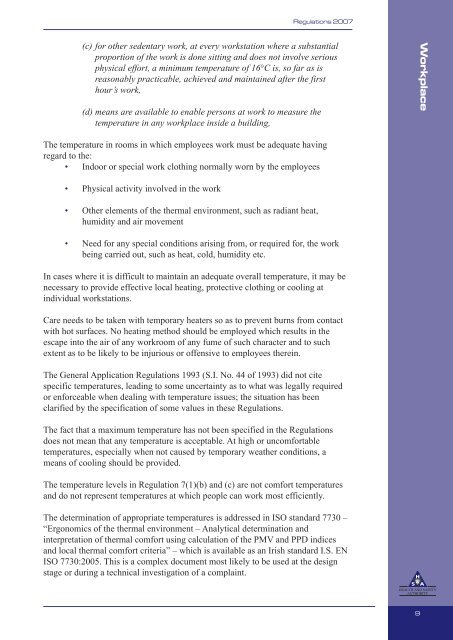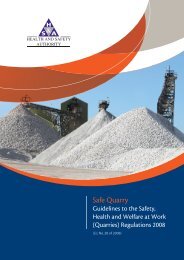Guide to the Safety, Health and Welfare at Work (General Application)
Guide to the Safety, Health and Welfare at Work (General Application)
Guide to the Safety, Health and Welfare at Work (General Application)
Create successful ePaper yourself
Turn your PDF publications into a flip-book with our unique Google optimized e-Paper software.
Regul<strong>at</strong>ions 2007<br />
(c) for o<strong>the</strong>r sedentary work, <strong>at</strong> every workst<strong>at</strong>ion where a substantial<br />
proportion of <strong>the</strong> work is done sitting <strong>and</strong> does not involve serious<br />
physical effort, a minimum temper<strong>at</strong>ure of 16°C is, so far as is<br />
reasonably practicable, achieved <strong>and</strong> maintained after <strong>the</strong> first<br />
hour’s work,<br />
(d) means are available <strong>to</strong> enable persons <strong>at</strong> work <strong>to</strong> measure <strong>the</strong><br />
temper<strong>at</strong>ure in any workplace inside a building,<br />
<strong>Work</strong>place<br />
The temper<strong>at</strong>ure in rooms in which employees work must be adequ<strong>at</strong>e having<br />
regard <strong>to</strong> <strong>the</strong>:<br />
• Indoor or special work clothing normally worn by <strong>the</strong> employees<br />
• Physical activity involved in <strong>the</strong> work<br />
• O<strong>the</strong>r elements of <strong>the</strong> <strong>the</strong>rmal environment, such as radiant he<strong>at</strong>,<br />
humidity <strong>and</strong> air movement<br />
• Need for any special conditions arising from, or required for, <strong>the</strong> work<br />
being carried out, such as he<strong>at</strong>, cold, humidity etc.<br />
In cases where it is difficult <strong>to</strong> maintain an adequ<strong>at</strong>e overall temper<strong>at</strong>ure, it may be<br />
necessary <strong>to</strong> provide effective local he<strong>at</strong>ing, protective clothing or cooling <strong>at</strong><br />
individual workst<strong>at</strong>ions.<br />
Care needs <strong>to</strong> be taken with temporary he<strong>at</strong>ers so as <strong>to</strong> prevent burns from contact<br />
with hot surfaces. No he<strong>at</strong>ing method should be employed which results in <strong>the</strong><br />
escape in<strong>to</strong> <strong>the</strong> air of any workroom of any fume of such character <strong>and</strong> <strong>to</strong> such<br />
extent as <strong>to</strong> be likely <strong>to</strong> be injurious or offensive <strong>to</strong> employees <strong>the</strong>rein.<br />
The <strong>General</strong> Applic<strong>at</strong>ion Regul<strong>at</strong>ions 1993 (S.I. No. 44 of 1993) did not cite<br />
specific temper<strong>at</strong>ures, leading <strong>to</strong> some uncertainty as <strong>to</strong> wh<strong>at</strong> was legally required<br />
or enforceable when dealing with temper<strong>at</strong>ure issues; <strong>the</strong> situ<strong>at</strong>ion has been<br />
clarified by <strong>the</strong> specific<strong>at</strong>ion of some values in <strong>the</strong>se Regul<strong>at</strong>ions.<br />
The fact th<strong>at</strong> a maximum temper<strong>at</strong>ure has not been specified in <strong>the</strong> Regul<strong>at</strong>ions<br />
does not mean th<strong>at</strong> any temper<strong>at</strong>ure is acceptable. At high or uncomfortable<br />
temper<strong>at</strong>ures, especially when not caused by temporary wea<strong>the</strong>r conditions, a<br />
means of cooling should be provided.<br />
The temper<strong>at</strong>ure levels in Regul<strong>at</strong>ion 7(1)(b) <strong>and</strong> (c) are not comfort temper<strong>at</strong>ures<br />
<strong>and</strong> do not represent temper<strong>at</strong>ures <strong>at</strong> which people can work most efficiently.<br />
The determin<strong>at</strong>ion of appropri<strong>at</strong>e temper<strong>at</strong>ures is addressed in ISO st<strong>and</strong>ard 7730 –<br />
“Ergonomics of <strong>the</strong> <strong>the</strong>rmal environment – Analytical determin<strong>at</strong>ion <strong>and</strong><br />
interpret<strong>at</strong>ion of <strong>the</strong>rmal comfort using calcul<strong>at</strong>ion of <strong>the</strong> PMV <strong>and</strong> PPD indices<br />
<strong>and</strong> local <strong>the</strong>rmal comfort criteria” – which is available as an Irish st<strong>and</strong>ard I.S. EN<br />
ISO 7730:2005. This is a complex document most likely <strong>to</strong> be used <strong>at</strong> <strong>the</strong> design<br />
stage or during a technical investig<strong>at</strong>ion of a complaint.<br />
9

















